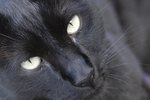
When a frog catches his prey, he's not closing his eyes to savor the tasty morsel. Instead, he's using his eyes to help him swallow his food whole. It might take several tries to completely swallow his meal, during which time he'll blink often to help get the food down.
Primary Swallowing Muscle
Frogs' long and fast tongues are good for more than just catching insects. They also are the primary muscle frogs use to push food down their throats. Frogs don't have teeth, which means they can't chew their food into smaller pieces. Instead, they eat their food whole, taking several swallows to get the food out of their mouths.
Why It Works
Many animals have eyes that rest in bony sockets, or open circles of bone that support the eyes. These sockets secure the muscles that hold the eyes in place and help the eyes move. Frogs lack these bony sockets. Instead, a frog has a thin membrane separating his eyes from the top of his mouth. The membrane is strong enough to hold his eyes in place, but flexible enough to arch downward into the mouth as needed. This membrane is what touches the food -- not the eyes themselves.
The Eyes Have It
To help move the food along, frogs close their eyes and push downward with their eyelids. This presses on the food in their mouths, serving two purposes: holding the prey steady so the tongue can move it backward and pushing downward enough to help propel the food toward the throat.
Other Swallowing Motion
Frogs have another trick they use to help get large prey down their throats and into their stomachs. As a frog starts to swallow, he often lifts his nose and stretches his head upward. This holds his throat at a steeper angle, allowing his meal to slide down easier. All the motions happen at once; as he lifts his head, he pushes backward with his tongue and down with his eyes to move the food down his throat.
References
Photo Credits
-
Jupiterimages/Photos.com/Getty Images




